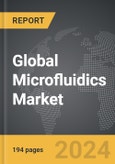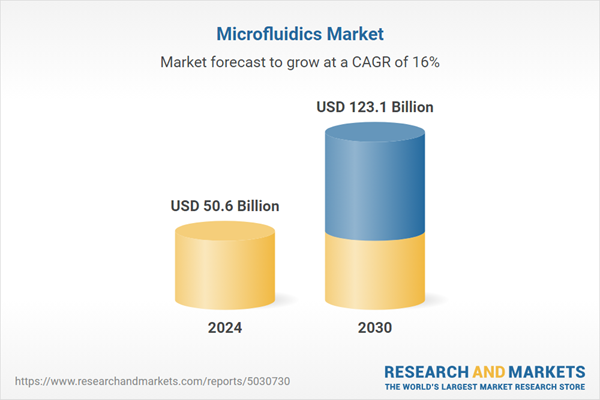Global Microfluidics Market - Key Trends & Drivers Summarized
What Is Microfluidics, and How Is It Revolutionizing Diagnostics and Research?
Microfluidics refers to the technology that processes or manipulates small amounts of fluids, usually on the scale of microliters or nanoliters, using channels with dimensions of tens to hundreds of micrometers. This field has become fundamental in biological and chemical analysis, playing a crucial role in the development of point-of-care diagnostics, lab-on-a-chip systems, and molecular diagnostics. The precision and control offered by microfluidic devices enable highly efficient sample processing, reduced reagent use, and faster reaction times, which are essential for rapid diagnostics and environmental monitoring. Additionally, microfluidics is integral to the advancement of personalized medicine, as it allows for the manipulation and analysis of single cells or small groups of molecules, paving the way for customized therapeutic strategies based on individual genetic profiles.Why Are Microfluidic Devices Increasingly Essential in Medical and Environmental Applications?
Microfluidic devices are increasingly recognized for their potential to transform both medical diagnostics and environmental monitoring. In healthcare, microfluidic chips facilitate rapid, accurate, and cost-effective analysis of a wide range of biological samples, supporting the quick diagnosis of diseases such as cancer and infectious diseases at the point of care. This capability is crucial for reducing the reliance on centralized laboratories and for expanding access to medical testing in low-resource settings. In environmental applications, microfluidic devices are used for monitoring air and water quality by detecting pollutants and pathogens swiftly and with high sensitivity, contributing to better environmental health and safety.How Does Innovation Drive the Microfluidics Industry Forward?
Innovation in the microfluidics industry is driven by advancements in material science, nanotechnology, and integration with digital technologies. The development of new materials that are more compatible with biological samples and reagents enhances the functionality and durability of microfluidic devices. Innovations in 3D printing and nanofabrication techniques have also significantly reduced the cost and complexity of device manufacturing, making microfluidic products more accessible. Furthermore, the integration of microfluidics with sensors and digital data analytics tools is enhancing the capability of these devices to perform complex analyses, leading to smarter, connected lab-on-a-chip systems that can provide real-time data for clinical decision-making and environmental management.Growth in the Microfluidics Market Is Driven by Several Factors
The growth in the Microfluidics market is driven by several factors, including the growing demand for point-of-care testing and the increasing adoption of personalized medicine. The expansion of applications in pharmaceutical and life science research, such as drug screening and proteomics, also contributes to market growth. Consumer trends towards portable and user-friendly diagnostic devices, coupled with healthcare decentralization, further fuel the adoption of microfluidic technologies. Additionally, increasing investments in healthcare infrastructure and research and development by both government and private sectors are propelling the industry forward. As microfluidics continues to intersect with other technological advancements, its integration into diverse scientific and industrial areas is likely to expand, sustaining its growth in the coming years.Report Scope
The report analyzes the Microfluidics market, presented in terms of market value (USD). The analysis covers the key segments and geographic regions outlined below.- Segments: Offering (Devices, Components); Application (In-Vitro Diagnostics, Pharmaceutical & Life Science Research and Manufacturing, Therapeutics).
- Geographic Regions/Countries: World; United States; Canada; Japan; China; Europe (France; Germany; Italy; United Kingdom; Spain; Russia; and Rest of Europe); Asia-Pacific (Australia; India; South Korea; and Rest of Asia-Pacific); Latin America (Argentina; Brazil; Mexico; and Rest of Latin America); Middle East (Iran; Israel; Saudi Arabia; United Arab Emirates; and Rest of Middle East); and Africa.
Key Insights:
- Market Growth: Understand the significant growth trajectory of the Microfluidics Devices segment, which is expected to reach US$63.5 Billion by 2030 with a CAGR of 14.4%. The Microfluidics Components segment is also set to grow at 17.8% CAGR over the analysis period.
- Regional Analysis: Gain insights into the U.S. market, valued at $13 Billion in 2024, and China, forecasted to grow at an impressive 20.5% CAGR to reach $30.2 Billion by 2030. Discover growth trends in other key regions, including Japan, Canada, Germany, and the Asia-Pacific.
Why You Should Buy This Report:
- Detailed Market Analysis: Access a thorough analysis of the Global Microfluidics Market, covering all major geographic regions and market segments.
- Competitive Insights: Get an overview of the competitive landscape, including the market presence of major players across different geographies.
- Future Trends and Drivers: Understand the key trends and drivers shaping the future of the Global Microfluidics Market.
- Actionable Insights: Benefit from actionable insights that can help you identify new revenue opportunities and make strategic business decisions.
Key Questions Answered:
- How is the Global Microfluidics Market expected to evolve by 2030?
- What are the main drivers and restraints affecting the market?
- Which market segments will grow the most over the forecast period?
- How will market shares for different regions and segments change by 2030?
- Who are the leading players in the market, and what are their prospects?
Report Features:
- Comprehensive Market Data: Independent analysis of annual sales and market forecasts in US$ Million from 2024 to 2030.
- In-Depth Regional Analysis: Detailed insights into key markets, including the U.S., China, Japan, Canada, Europe, Asia-Pacific, Latin America, Middle East, and Africa.
- Company Profiles: Coverage of players such as Abbott Laboratories, Agilent Technologies, Inc., Becton, Dickinson and Company, bioMerieux SA, Bio-Rad Laboratories, Inc. and more.
- Complimentary Updates: Receive free report updates for one year to keep you informed of the latest market developments.
Some of the 42 companies featured in this Microfluidics market report include:
- Abbott Laboratories
- Agilent Technologies, Inc.
- Becton, Dickinson and Company
- bioMerieux SA
- Bio-Rad Laboratories, Inc.
- Cellix Biosciences Inc,
- Danaher Corporation
- Dolomite Microfluidics
- Elveflow
- F. Hoffmann-La Roche AG
- Fluidigm Corporation
- Illumina, Inc.
- Microfluidic ChipShop GmbH
- Micronit Microtechnologies
- PerkinElmer, Inc.
- Qiagen NV
- Thermo Fisher Scientific, Inc.
This edition integrates the latest global trade and economic shifts into comprehensive market analysis. Key updates include:
- Tariff and Trade Impact: Insights into global tariff negotiations across 180+ countries, with analysis of supply chain turbulence, sourcing disruptions, and geographic realignment. Special focus on 2025 as a pivotal year for trade tensions, including updated perspectives on the Trump-era tariffs.
- Adjusted Forecasts and Analytics: Revised global and regional market forecasts through 2030, incorporating tariff effects, economic uncertainty, and structural changes in globalization. Includes historical analysis from 2015 to 2023.
- Strategic Market Dynamics: Evaluation of revised market prospects, regional outlooks, and key economic indicators such as population and urbanization trends.
- Innovation & Technology Trends: Latest developments in product and process innovation, emerging technologies, and key industry drivers shaping the competitive landscape.
- Competitive Intelligence: Updated global market share estimates for 2025, competitive positioning of major players (Strong/Active/Niche/Trivial), and refined focus on leading global brands and core players.
- Expert Insight & Commentary: Strategic analysis from economists, trade experts, and domain specialists to contextualize market shifts and identify emerging opportunities.
Table of Contents
Companies Mentioned (Partial List)
A selection of companies mentioned in this report includes, but is not limited to:
- Abbott Laboratories
- Agilent Technologies, Inc.
- Becton, Dickinson and Company
- bioMerieux SA
- Bio-Rad Laboratories, Inc.
- Cellix Biosciences Inc,
- Danaher Corporation
- Dolomite Microfluidics
- Elveflow
- F. Hoffmann-La Roche AG
- Fluidigm Corporation
- Illumina, Inc.
- Microfluidic ChipShop GmbH
- Micronit Microtechnologies
- PerkinElmer, Inc.
- Qiagen NV
- Thermo Fisher Scientific, Inc.
Table Information
| Report Attribute | Details |
|---|---|
| No. of Pages | 194 |
| Published | December 2025 |
| Forecast Period | 2024 - 2030 |
| Estimated Market Value ( USD | $ 50.6 Billion |
| Forecasted Market Value ( USD | $ 123.1 Billion |
| Compound Annual Growth Rate | 16.0% |
| Regions Covered | Global |









